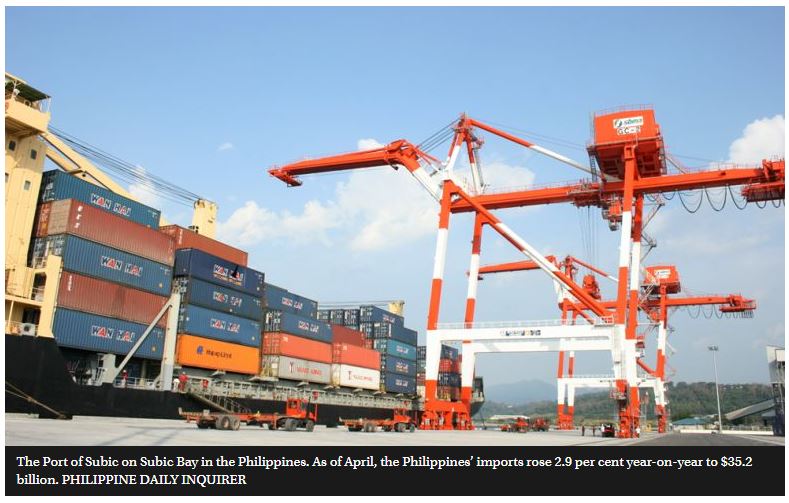Institute of Int’l Finance: Rising imports to help Philippines post stronger growth
The Philippines stands to benefit from rising imports while most of its Asean neighbours suffer from declining shipments from overseas, which is seen to hurt their economies in the near term, the Washington-based Institute of International Finance (IIF) said.
With strong imports, including those of capital equipment, the Philippines is seen to have a better chance to rebound from a slow first-quarter growth, the IIF said.
The sluggish global trading environment has led to a sharp import compression in major Southeast Asian economies and in South Korea in the first half of this year.
Except for the Philippines, the large Asean economies and South Korea all posted sharp tumbles in external trade, IIF research head for Asean and India Reza Siregar and associate economist Yuanliu Hu said in a June 24 Asean Economic Views report titled Import Compression: Unraveling Growth Outlook.
The report said major traders in the region experienced consecutive months of sharp year-on-year declines in capital imports beginning as early as late last year.
“Learning from past experiences, the recent fall in imports should, in our view, offset the impact of weak exports on the overall net export balance and support the current account position.
“However, the multiplier effects of import contraction on investment will likely dampen the GDP [gross domestic product] growth outlook for countries in the region this year and possibly the next,” the IIF said.
The IIF warned that since import flows were highly linked to investment flows, the sharp reduction in capital and intermediate imports being experienced by Indonesia, Malaysia, Thailand and South Korea signalled a slowdown in foreign direct investment (FDI) flows and therefore weaker investment outlooks for these countries.
“Except for Malaysia, we find that countries with a high export and import correlation – such as South Korea and Thailand – tend to report a relatively high FDI-capital import correlation,” according to the IIF.
“The trade-offs between net exports and investment due to import compression are, in fact, not new.
“Fallen imports contributed to stronger current account positions, sluggish investments, and slower GDP growth during the 1997 East Asian crisis and the 2008 global financial crisis in South Korea, Malaysia, and Thailand.”
‘More timely execution’
In the case of the Philippines, which bucked the trend of declining imports, Siregar told Philippine Daily Inquirer in an email that “since imports remained relatively strong, including capital imports, we should expect growth to rebound from its level in the first quarter of 2019”.
As of April, the Philippines’ imports rose 2.9 per cent year-on-year to $35.2 billion.
But Siregar said the recovery in GDP growth could only happen if it was coupled with “more timely execution of fiscal spending”.
GDP expansion fell to a four-year low of 5.6 per cent in the first quarter, below the government’s downgraded six to seven per cent full-year target range, as the government operated under re-enacted 2018 appropriations at the start of the year and underspent about one billion pesos ($19.6 million) per day.
President Rodrigo Duterte signed the 3.7 trillion pesos 2019 national budget only on April 15, or more than four months late, as the two houses of Congress squabbled over pork funds.
At present, the government was implementing a catch-up spending plan to reverse the slower first-quarter GDP growth.
However, Siregar acknowledged the problems also being caused by increasing imports and declining exports.
“Indeed, the challenge facing the Philippines is more on maintaining external imbalance – the current account imbalance,” Siregar said.
This challenge, he said, was amplified by the tighter competition on the financial account side amid the expected weaker global economy.
Attracting FDIs and portfolio investment to finance the current account deficit and keeping surplus balance of payments can be more challenging in the coming quarter, Siregar added.
The current account deficit ballooned to $1.216 billion as of end-March, equivalent to 1.5 per cent of GDP, from only $322 million, or 0.4 per cent, of GDP last year.
This wider current account gap had been attributed by the government to the also bigger first-quarter trade-in-goods deficit, which at $12.4 billion was 17.3 per cent larger than a year ago amid faster growth of imports over exports.
The prevailing current account deficit had been putting pressure on the peso, which weakened to 12-year lows last year.
Economic managers had said that with the Duterte administration’s ambitious “Build, Build, Build” infrastructure programme in full swing, demand for imports of mostly capital goods would remain strong in the near term. PHILIPPINE DAILY INQUIRER
Source: https://www.phnompenhpost.com/business/institute-intl-finance-rising-imports-help-philippines-post-stronger-growth


 English
English




